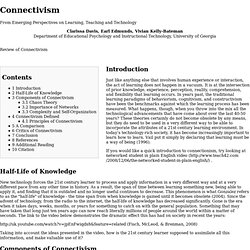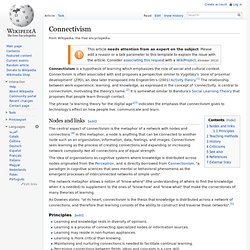

Differentiating Instruction: Meeting Students Where They Are, Teaching Today, Glencoe Online. Differentiating Instruction: Meeting Students Where They Are, Teaching Today, Glencoe Online. Connectivism. From Emerging Perspectives on Learning, Teaching and Technology Clarissa Davis, Earl Edmunds, Vivian Kelly-Bateman Department of Educational Psychology and Instructional Technology, University of Georgia Review of Connectivism Introduction Just like anything else that involves human experience or interaction, the act of learning does not happen in a vacuum.

It is at the intersection of prior knowledge, experience, perception, reality, comprehension, and flexibility that learning occurs. If you would like a quick introduction to connectionism, try looking at networked student in plain English video. Half-Life of Knowledge New technology forces the 21st century learner to process and apply information in a very different way and at a very different pace from any other time in history. (Fisch, McLeod, & Brenman, 2008) Taking into account the ideas presented in the video, how is the 21st century learner supposed to assimilate all this information, and make valuable use of it? Chaos Theory Kerr, B. : betekenisvol leren. Breinbewust onderwijs: leren. Content v process debate. Pedagogical Ideas.
Emerging Perspectives on Learning, Teaching and Technology. Connectivism: A Learning Theory for the Digital Age. Connectivism: A Learning Theory for the Digital Age December 12, 2004 George Siemens Update (April 5, 2005): I've added a website to explore this concept at www.connectivism.ca Introduction Behaviorism, cognitivism, and constructivism are the three broad learning theories most often utilized in the creation of instructional environments.

Learners as little as forty years ago would complete the required schooling and enter a career that would often last a lifetime. “One of the most persuasive factors is the shrinking half-life of knowledge. Some significant trends in learning: Many learners will move into a variety of different, possibly unrelated fields over the course of their lifetime. Background Driscoll (2000) defines learning as “a persisting change in human performance or performance potential…[which] must come about as a result of the learner’s experience and interaction with the world” (p.11). Driscoll (2000, p14-17) explores some of the complexities of defining learning. Conclusion: Connectivism. Connectivism is a hypothesis of learning which emphasizes the role of social and cultural context.

Connectivism is often associated with and proposes a perspective similar to Vygotsky's 'zone of proximal development' (ZPD), an idea later transposed into Engeström's (2001) Activity theory.[1] The relationship between work experience, learning, and knowledge, as expressed in the concept of ‘connectivity, is central to connectivism, motivating the theory's name.[2] It is somewhat similar to Bandura's Social Learning Theory that proposes that people learn through contact. The phrase "a learning theory for the digital age"[3] indicates the emphasis that connectivism gives to technology's effect on how people live, communicate and learn. Nodes and links[edit] The central aspect of connectivism is the metaphor of a network with nodes and connections.[4] In this metaphor, a node is anything that can be connected to another node such as an organization, information, data, feelings, and images.
Emerging Perspectives on Learning, Teaching and Technology. Connectivism. Connectivism. My eBooks. Connective_Knowledge-19May2012.pdf. A review of research on the impact of professional learning communities on teaching practice and student learning. Abstract After an overview of the characteristics of professional learning communities (PLCs), this manuscript presents a review of 10 American studies and one English study on the impact of PLCs on teaching practices and student learning.

Although, few studies move beyond self-reports of positive impact, a small number of empirical studies explore the impact on teaching practice and student learning. The collective results of these studies suggest that well-developed PLCs have positive impact on both teaching practice and student achievement. Implications of this research and suggestions for next steps in the efforts to document the impact of PLCs on teaching and learning are included. Keywords Professional development; School culture; Teaching practice; Student achievement; Teacher collaboration 1. Over the past 20 yr there has been a paradigm shift gathering momentum with regard to the professional development of teachers. 2. 3.
The studies for our review come from two key sources. Timeline of theorists about student motivation. Impliciet tegenover expliciet leren. Srinivasan%20Article. Problem-Based Learning - Home. Economics of Education Review.